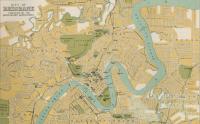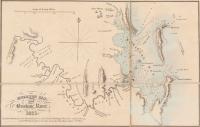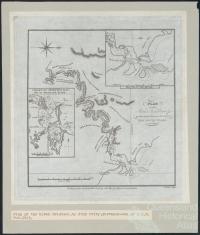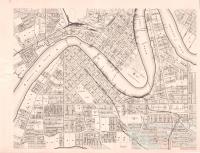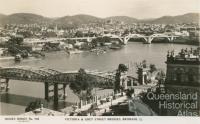- Home
- Quintessential Queensland
- Distinctiveness
- Perceptions
- Perceptions: how people understand the landscape
- From runs to closer settlement
- Geological survey of Queensland
- Mapping a new colony, 1860-80
- Mapping the Torres Strait: from TI to Magani Malu and Zenadh Kes
- Order in Paradise: a colonial gold field
- Queensland atlas, 1865
- Queensland mapping since 1900
- Queensland: the slogan state
- Rainforests of North Queensland
- Walkabout
- Queenslanders
- Queenslanders: people in the landscape
- Aboriginal heroes: episodes in the colonial landscape
- Australian South Sea Islanders
- Cane fields and solidarity in the multiethnic north
- Chinatowns
- Colonial immigration to Queensland
- Greek Cafés in the landscape of Queensland
- Hispanics and human rights in Queensland’s public spaces
- Italians in north Queensland
- Lebanese in rural Queensland
- Queensland clothing
- Queensland for ‘the best kind of population, primary producers’
- Too remote, too primitive and too expensive: Scandinavian settlers in colonial Queensland
- Distance
- Movement
- Movement: how people move through the landscape
- Air travel in Queensland
- Bicycling through Brisbane, 1896
- Cobb & Co
- Journey to Hayman Island, 1938
- Law and story-strings
- Mobile kids: children’s explorations of Cherbourg
- Movable heritage of North Queensland
- Passages to India: military linkages with Queensland
- The Queen in Queensland, 1954
- Transient Chinese in colonial Queensland
- Travelling times by rail
- Pathways
- Pathways: how things move through the landscape and where they are made
- Aboriginal dreaming paths and trading ways
- Chinese traders in the nineteenth century
- Introducing the cane toad
- Pituri bag
- Press and the media
- Radio in Queensland
- Red Cross Society and World War I in Queensland
- The telephone in Queensland
- Where did the trams go?
- ‘A little bit of love for me and a murder for my old man’: the Queensland Bush Book Club
- Movement
- Division
- Separation
- Separation: divisions in the landscape
- Asylums in the landscape
- Brisbane River
- Changing landscape of radicalism
- Civil government boundaries
- Convict Brisbane
- Dividing Queensland - Pauline Hanson’s One Nation Party
- High water mark: the shifting electoral landscape 2001-12
- Hospitals in the landscape
- Indigenous health
- Palm Island
- Secession movements
- Separate spheres: gender and dress codes
- Separating land, separating culture
- Stone walls do a prison make: law on the landscape
- The 1967 Referendum – the State comes together?
- Utopian communities
- Whiteness in the tropics
- Conflict
- Conflict: how people contest the landscape
- A tale of two elections – One Nation and political protest
- Battle of Brisbane – Australian masculinity under threat
- Dangerous spaces - youth politics in Brisbane, 1960s-70s
- Fortress Queensland 1942-45
- Grassy hills: colonial defence and coastal forts
- Great Shearers’ Strike of 1891
- Iwasaki project
- Johannes Bjelke-Petersen: straddling a barbed wire fence
- Mount Etna: Queensland's longest environmental conflict
- Native Police
- Skyrail Cairns (Research notes)
- Staunch but conservative – the trade union movement in Rockhampton
- The Chinese question
- Thomas Wentworth Wills and Cullin-la-ringo Station
- Separation
- Dreaming
- Imagination
- Imagination: how people have imagined Queensland
- Brisbane River and Moreton Bay: Thomas Welsby
- Changing views of the Glasshouse Mountains
- Imagining Queensland in film and television production
- Jacaranda
- Literary mapping of Brisbane in the 1990s
- Looking at Mount Coot-tha
- Mapping the Macqueen farm
- Mapping the mythic: Hugh Sawrey's ‘outback’
- People’s Republic of Woodford
- Poinsettia city: Brisbane’s flower
- The Pineapple Girl
- The writers of Tamborine Mountain
- Vance and Nettie Palmer
- Memory
- Memory: how people remember the landscape
- Anna Wickham: the memory of a moment
- Berajondo and Mill Point: remembering place and landscape
- Cemeteries in the landscape
- Landscapes of memory: Tjapukai Dance Theatre and Laura Festival
- Monuments and memory: T.J. Byrnes and T.J. Ryan
- Out where the dead towns lie
- Queensland in miniature: the Brisbane Exhibition
- Roadside ++++ memorials
- Shipwrecks as graves
- The Dame in the tropics: Nellie Melba
- Tinnenburra
- Vanished heritage
- War memorials
- Curiosity
- Curiosity: knowledge through the landscape
- A playground for science: Great Barrier Reef
- Duboisia hopwoodii: a colonial curiosity
- Great Artesian Basin: water from deeper down
- In search of Landsborough
- James Cook’s hundred days in Queensland
- Mutual curiosity – Aboriginal people and explorers
- Queensland Acclimatisation Society
- Queensland’s own sea monster: a curious tale of loss and regret
- St Lucia: degrees of landscape
- Townsville’s Mount St John Zoo
- Imagination
- Development
- Exploitation
- Transformation
- Transformation: how the landscape has changed and been modified
- Cultivation
- Empire and agribusiness: the Australian Mercantile Land and Finance Company
- Gold
- Kill, cure, or strangle: Atherton Tablelands
- National parks in Queensland
- Pastoralism 1860s–1915
- Prickly pear
- Repurchasing estates: the transformation of Durundur
- Soil
- Sugar
- Sunshine Coast
- The Brigalow
- Walter Reid Cultural Centre, Rockhampton: back again
- Survival
- Survival: how the landscape impacts on people
- Brisbane floods: 1893 to the summer of sorrow
- City of the Damned: how the media embraced the Brisbane floods
- Depression era
- Did Clem Jones save Brisbane from flood?
- Droughts and floods and rail
- Missions and reserves
- Queensland British Food Corporation
- Rockhampton’s great flood of 1918
- Station homesteads
- Tropical cyclones
- Wreck of the Quetta
- Pleasure
- Pleasure: how people enjoy the landscape
- Bushwalking in Queensland
- Cherbourg that’s my home: celebrating landscape through song
- Creating rural attractions
- Festivals
- Queer pleasure: masculinity, male homosexuality and public space
- Railway refreshment rooms
- Regional cinema
- Schoolies week: a festival of misrule
- The sporting landscape
- Visiting the Great Barrier Reef
By:
Helen Gregory The Brisbane River divides Queensland’s capital city and threads its way through the suburbs and into its hinterland. The challenge of connecting Brisbane’s halves has both inspired and frustrated the citizens of the ‘River City’.
A cultural divide
The river has meant far more than physical separation. The first white settlers had little instinctive connection with the unfamiliar riverine landscape in which they found themselves. They grazed cattle and planted European crops, rather than rely on local foods in vivid contrast to the Aboriginal communities which thrived in the region since the end of the last ice age. The contest for possession of the riverlands forged an unbridgeable gap between old and new cultures.
The first generations of European settlers were willing to harvest nearby forests for building timbers and to quarry riverside cliffs for building stones, but were unwilling to accept the river in its natural state as a navigable artery to open up new areas to settle and develop. The river in its role as highway greatly influenced the shape of the city of Brisbane. In a hot, humid climate a spread of settlement from north to south along the wide, curving coast of Moreton Bay would seem appropriate; developing the convict settlement port at Dunwich on North Stradbroke Island into a Manhattan on Moreton Bay scarcely less so. Early immigrants to Brisbane faced an often frightening journey across the Bay which, rather than a pleasant centre of settlement, became a difficult foyer to the river.
A class divide
Economic pressures were far more powerful forces than climate. From the convict era until the final decades of the twentieth century, the Brisbane River transported goods between the inefficient port in the city centre and the upper reaches as far as Ipswich, Queensland’s second oldest city. By the final quarter of the twentieth century, the port spread along the banks of the Brisbane River from the city centre to the river mouth. During all those decades, commercial interests cursed its meanders, shoals and shallows. The river bar was repeatedly dredged, the shoals were blasted and deeper and deeper navigable channels for larger and larger ships were created; training walls were built and the bends were shaved in an effort to bring the river’s meanders under control.
City development was inhibited by the awkward watery divide between the main port facilities on the south side and the administrative centre on the north. On the south side, warehouses and factories clustered around the old port and a huge rail terminal for bunker coal dominated the waterfront at Kangaroo Point. Raucous waterside pubs thrived; clusters of housing for waterside workers and a large general labour force were developed on the southern bank of the river. In the twentieth and twenty-first centuries immigrants from Europe and Asia invigorated the old working class suburbs on the southside, bringing with them new foods, different languages and unfamiliar customs. On the more genteel north bank, government administration and commercial headquarters resided in gracious buildings; ‘villa’ estates stretching east and west from the north Brisbane centre accommodated the leaders of government and the captains of industry.
Forging connections
For well over a century, the call for more and more bridges sparked dissent over where they were most needed and what they should carry: all comers, or vehicles only, or bicycles and pedestrians alone, or public transport in isolated comfort. As ‘green’ bridges for cyclists and pedestrians and new traffic bridges appear above the river in the early twenty-first century, the cross-river problem is also being buried in enormous tunnels beneath its bed.
Breaking the river
The Brisbane River carries enormous volumes of water, but its capacity to provide sufficient fresh water for the urban communities in its lower stretches and rural communities in its upper reaches has always been questionable. Water storage and purification works in the upper reaches attempted to address the problem, but disrupted natural environmental flows. Many of the fish species which had delighted recreational anglers and fed thousands of Brisbane families disappeared when fish could no longer reach spawning areas upstream.
Ignoring the river
The engineering of the river, whether to improve navigation or to manage the water supply, excluded Brisbane people in the city reaches and they turned their backs to it. Generations of buildings faced the street, rather than the industrialised wharfage, a huge concrete expressway was allowed to occupy precious space in the central business district along the northern bank with little demur. Only a few areas were reserved for public recreation and only wealthy suburbanites could afford to live on its banks; they chose only those areas high above flood levels.
Rediscovering the river
Technology of various kinds separated Brisbane people from their river for more than a century and, ironically, helped them to bond with it in recent decades. Containerised shipping changed the Brisbane River and riverside port areas all over the world. A new port on one side of the river mouth and a huge airport on the other have not improved the human amenity of the estuarine mouth but, for the first time since Aboriginal times, the people of the ‘River City’ have taken the river to their hearts.
The old port on the south side was razed to make way for temporary pavilions shaded by enormous quirky sails to house Expo 88, the international exposition which was part of the celebration of the bicentenary of white settlement in Australia. The pavilions gave way to parkland which, in the twenty-first century is being steadily eroded by apartment developments; no longer does the river divide the city on class lines. The wealthy command the waterfront. Even so, riverside bikeways, footpaths and parklands continue to attract new devotees no matter where they live. They defend the river passionately, even convincing government to abandon a large development scheme on the northern bank in the city centre. Nevertheless, fear that another huge flood will someday destroy lives, houses, bridges and buildings remains in the background, for the time being overshadowed by the glittering riverside city, the spacious leafy riverbank suburbs, and the colourful ferries which glide along the slow-flowing surface.
References and Further reading (Note):
Helen Gregory, The Brisbane River Story: meanders through time, Brisbane, Australian Marine Conservation Society, 1996
References and Further reading (Note):
Simon Cleary, The Comfort of Figs, St Lucia, University of Queensland Press, 2008 (2009)
References and Further reading (Note):
J. G. Steele, The Explorers of the Moreton Bay District 1770-1830, St Lucia, University of Queensland Press, 1972

